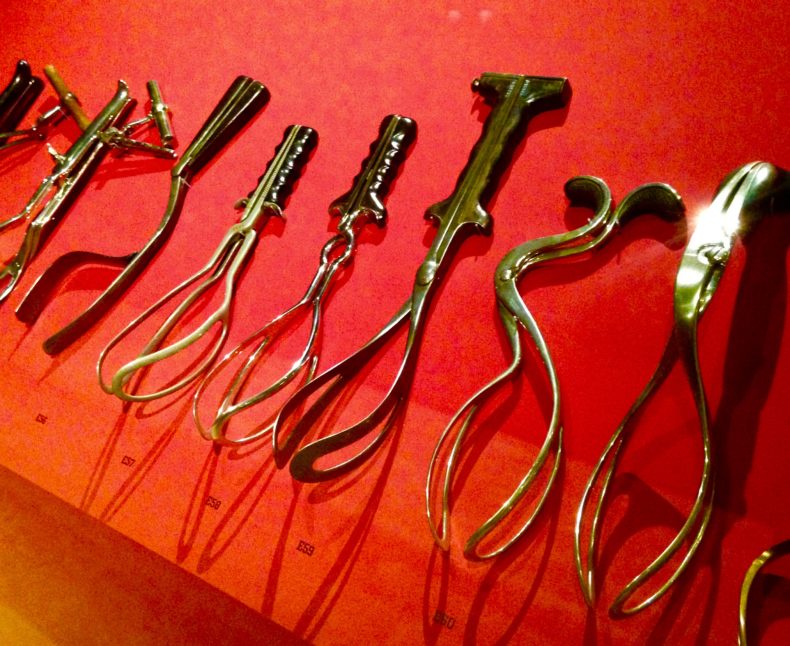One of the best free diversions in London is the Wellcome Collection, the medical museum operated by the Wellcome Trust and supported by the posthumous generosity of Sir Henry Wellcome, the American frontier kid who became a British pharmaceutical tycoon. “Medicine Man,” one of the permanent exhibitions, is drawn from Sir Henry’s own extraordinary collection of memorabilia related to health and the body. Though he was a Victorian, Wellcome was no prude, and the items span the breadth of human experience, from beautifully detailed medical models to Japanese sex aids to fearsome-looking anti-masturbation devices.
Only one display, though, is guaranteed to make those of us with female reproductive anatomy instinctively cross our legs: More than a dozen pairs of steel obstetric forceps, of varied size, shape, and vintage, are arrayed on blood-red fabric, positioned as if still ready to spoon out a dawdling baby.
Obstetric forceps were invented in the mid-1500s, when bloodletting was still a common medical practice. They predate the stethoscope and the germ theory of disease. They were also, for many years, a closely held trade secret. For more than three generations, as Randi Hutter Epstein writes in Get Me Out: A History of Childbirth from the Garden of Eden to the Sperm Bank, they were used exclusively by a single family of indifferently educated surgeons, the Chamberlens, who hid the steely secret of their success.
Forceps were a vast improvement on previous emergency-childbirth practices, which were more or less limited to breaking the mother’s pubic bone, performing a Caesarian section (procedures that could save the fetus but often killed the mother), or stabbing or cutting the fetus in utero (which invariably killed the fetus but sometimes saved the mother).
The Chamberlens and their forceps ended this ongoing zero-sum tragedy, and became famous as the best “man-midwives” in England. To maintain their reputation and boost their business, however, they concealed their forceps in medical bags and under surgical draperies. Not until the 1700s did they release the design of their invention, and the original instruments remained within the family until 1813, when a pair of Chamberlen forceps was discovered under the floorboards of a country mansion where the family once lived.
Forceps have saved countless lives, but when they are used badly, or unnecessarily, they can harm both mother and baby, sometimes severely. Despite their disadvantages, they remained the primary delivery-assistance tool short of a C-section until the 1950s, when the ventouse, or vacuum extractor, became widely available. The ventouse didn’t entirely replace forceps, for though the ventouse is physically far easier on both mother and baby, forceps are slightly better at actually getting the fetus out of the birth canal.
Forceps or vacuum extractors are now used in just over 3 percent of all U.S. deliveries, with forceps used in less than 1 percent. (C-sections, though declining, still represent more than 30 percent, and are in some cases preferred to forceps, either by physicians or mothers or both.) Many medical students, in the U.S. and elsewhere, receive minimal training and less hands-on experience in the use of forceps. This fall, in an article in Obstetrics and Gynecology, a trio of obstetricians bewailed “the inevitable disappearance of this valuable skill from the obstetric armamentarium,” and recommended practice with computer simulations. This drew a tart response in the letters section, with one obstetrician calling the preservation of forceps a “hopeless endeavor,” detailing the appalling and permanent injury they can do to mothers, and pointing out that the recent abandonment of forceps in Denmark has had no effect on the country’s perinatal statistics. (One counter-argument is that because of their marginally better success in preventing C-sections, forceps may still be useful in situations where surgery is unavailable or unusually risky.)
The real trouble, however, is the shockingly slow rate of technological advancement in women’s health care. The only recent addition to the “obstetric armamentarium” is the Odón device, a simple tool that uses an inflatable plastic bag to draw the fetus out of the birth canal. Invented in 2006 by an Argentine car mechanic, it has been endorsed by the World Health Organization and licensed for production by the U.S. company Becton Dickinson, which expects to sell the devices for about $50 each. That’s good news, but for now, mothers must still, in some circumstances, choose between major abdominal surgery or a tool invented almost four centuries ago.
Moore’s law holds that the performance of integrated circuits doubles every 18 months. The obstetric armamentarium has expanded, on average, once every 228 years. Women—and babies—pay the price for the difference.
Top photo taken, with permission, at the Wellcome Collection.
